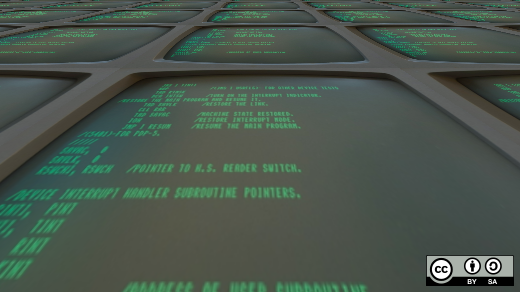I recently read Scott Nesbitt's article "Using less to view text files at the Linux command line" and was inspired to share additional tips and tricks I use with less.
LESS env var
If you have an environment variable LESS defined (e.g., in your .bashrc), less treats it as a list of options, as if passed on the command line.
I use this:
LESS='-C -M -I -j 10 -# 4'
These mean:
-C– Make full-screen reprints faster by not scrolling from the bottom.-M– Show more information from the last (status) line. You can customize the information shown with-PM, but I usually do not bother.-I– Ignore letter case (upper/lower) in searches.-j 10– Show search results in line 10 of the terminal, instead of the first line. This way you have 10 lines of context each time you pressn(orN) to jump to the next (or previous) match.-# 4– Jump four characters to the right or left when pressing the Right or Left arrow key. The default is to jump half of the screen, which I usually find to be too much. Generally speaking,lessseems to be (at least partially) optimized to the environment it was initially developed in, with slow modems and low-bandwidth internet connections, when it made sense to jump half a screen.
PAGER env var
Many programs show information using the command set in the PAGER environment variable (if it's set). So, you can set PAGER=less in your .bashrc and have your program run less. Check the man page environ(7) (man 7 environ) for other such variables.
-S
The command-line option -S tells less to chop long lines instead of wrapping them. I rarely find a need for this unless (and until) I've started viewing a file. Fortunately, you can type all command-line options inside less as if they were keyboard commands. So, if I want to chop long lines while I'm already in a file, I can simply type -S.
Here's an example I use a lot:
su - postgres
export PAGER=less # Because I didn't bother editing postgres' .bashrc on all the machines I use it on
psqlSometimes when I later view the output of a SELECT command with a very wide output, I type -S so it will be formatted nicely. If it jumps too far when I press the Right arrow to see more (because I didn't set -#), I can type -#8, then each Right arrow press will move eight characters to the right.
Sometimes after typing -S too many times, I exit psql and run it again after entering:
export LESS=-SF
The command F makes less work like tail -f—waiting until more data is added to the file before showing it. One advantage this has over tail -f is that highlighting search matches still works. So you can enter less /var/log/logfile, search for something—which will highlight all occurrences of it (unless you used -g)—and then press F. When more data is written to the log, less will show it and highlight the new matches.
After you press F, you can press Ctrl+C to stop it from looking for new data (this will not kill it); go back into the file to see older stuff, search for other things, etc.; and then press F again to look at more new data.
Searching
Searches use the system's regexp library, and this usually means you can use extended regular expressions. In particular, searching for one|two|three will find and highlight all occurrences of one, two, or three.
Another pattern I use a lot, especially with wide log lines (e.g., ones that span more than one terminal line), is .*something.*, which highlights the entire line. This pattern makes it much easier to see where a line starts and finishes. I also combine these, such as: .*one thing.*|.*another thing.*, or key: .*|.*marker.* to see the contents of key (e.g., in a log file with a dump of some dictionary/hash) and highlight relevant marker lines (so I have a context), or even, if I know the value is surrounded by quotes:
key: '[^']*'|.*marker.*less maintains a history of your search items and saves them to disk for future invocations. When you press / (or ?), you can go through this history with the Up or Down arrow (as well as do basic line editing).
I stumbled upon what seems to be a very useful feature when skimming through the less man page while writing this article: skipping uninteresting lines with &!pattern. For example, while looking for something in /var/log/messages, I used to iterate through this list of commands:
cat /var/log/messages | egrep -v 'systemd: Started Session' | less
cat /var/log/messages | egrep -v 'systemd: Started Session|systemd: Starting Session' | less
cat /var/log/messages | egrep -v 'systemd: Started Session|systemd: Starting Session|User Slice' | less
cat /var/log/messages | egrep -v 'systemd: Started Session|systemd: Starting Session|User Slice|dbus' | less
cat /var/log/messages | egrep -v 'systemd: Started Session|systemd: Starting Session|User Slice|dbus|PackageKit Daemon' | lessBut now I know how to do the same thing within less. For example, I can type &!systemd: Started Session, then decide I want to get rid of systemd: Starting Session, so I add it by typing &! and use the Up arrow to get the previous search from the history. Then I type |systemd: Starting Session and press Enter, continuing to add more items the same way until I filter out enough to see the more interesting stuff.
=
The command = shows more information about the file and location, even more than -M. If the file is very long, and calculating = takes too long, you can press Ctrl+C and it will stop trying.
If the content you're viewing is from a pipe rather than a file, = (and -M) will not show what it does not know, including the number of lines and bytes in the file. To see that data, if you know that command will finish quickly, you can jump to the end with G, and then less will start showing that information.
If you press G and the command writing to the pipe takes longer than expected, you can press Ctrl+C, and the command will be killed. Pressing Ctrl+C will kill it even if you didn't press G, so be careful not to press Ctrl+C accidentally if you don't intend to kill it. For this reason, if the command does something (that is, it's not only showing information), it's usually safer to write its output to a file and view the file in a separate terminal, instead of using a pipe.
Why you need less
less is a very powerful program, and contrary to newer contenders in this space, such as most and moar, you are likely to find it on almost all the systems you use, just like vi. So, even if you use GUI viewers or editors, it's worth investing some time going through the less man page, at least to get a feeling of what's available. This way, when you need to do something that might be covered by existing functionality, you'll know to search the manual page or the internet to find what you need.
For more information, visit the less home page. The site has a nice FAQ with more tips and tricks.







8 Comments